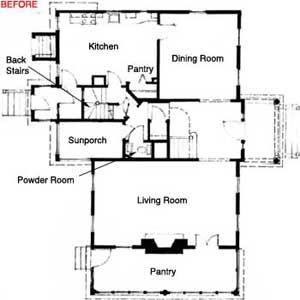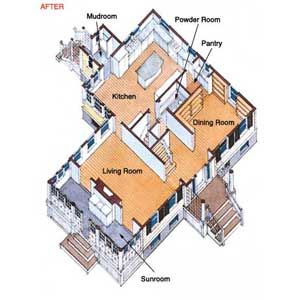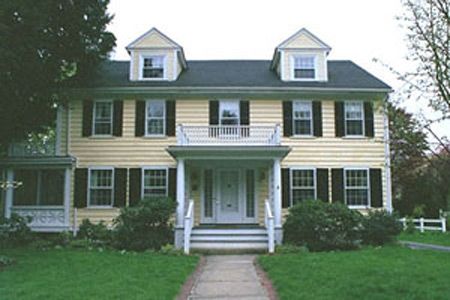
“We’re not going to change much up here at all,” said homeowner Kim Whittemore, as she pointed to the formal living and dining rooms at the front of her 1922 Colonial Revival in Winchester, Massachusetts. But as she and her husband, Bruce Leasure, navigated a cramped rear hallway and a matrix of doorways to enter what once was the outdated kitchen, it became clear that they wouldn’t say the same about the back rooms. The rear wall of the house was gone, recently removed by This Old House general contractor Tom Silva and his crew, and it’s wide open to the backyard. “This is where all the action is taking place,” said Bruce, amid the whine of circular saws and the slap of plywood dropping onto the joists of a small kitchen addition.
And so began the work on another This Old House television project. After give-and-take between drawing board and checkbook, the plans— by local architect David Stirling — were finished. Along with the new eat-in kitchen and redesigned rear entry, the master suite was reconfigured to enlarge the bath. Plans called for a media room and a wine cellar in the basement and an office and a cedar closet in the attic. But for the most part — and certainly with a view to the front facade— the house’s exterior appeared unchanged when the crew wrapped up just before Christmas. “Since the first time we saw the house,” said Kim, “our thoughts have been not about what we want to change but rather about how much we want to keep it the same.”

An outdated kitchen grows into a gathering spot
“The back hall of the ground floor felt like some kind of strange carnival funhouse,” said Kim. “Six doors led to a coat closet, half bath, basement, closed-off back porch, back stairs, and, finally, kitchen. It was a confusing disaster.” Behind the kitchen were more doors — to another hall and to the backyard. “We wanted to clear up the confusion and create a larger kitchen, always the gathering place in our house,” said Kim.
Stirling’s design opened up the floor plan, which required removing the back stairs as high as the second floor (they remained to the attic). The new kitchen, larger by 180 square feet, featured a 7-foot island and a windowed breakfast corner. By moving a wall, Kim and Bruce were able to keep a pantry and a powder room on the first floor.
Once reachable only from the front hall, the living room was accessible directly from the kitchen as well. “It greatly improves the flow,” said Stirling, who added a second set of French doors from the living room to the sunroom. That space will lose leaky jalousie windows in favor of double-hung units, turning it into a true four-season room. “Then it will really seem like an extension of the living room,” said Stirling.

A clutter of rooms became the master bedroom suite
The majority of the work on the second floor was done in the master suite. A small rear bedroom and the old master bathroom was reconfigured into a larger bath and a dressing area with lots of closets. “Losing the bedroom was not a big concern for Bruce and Kim,” said Stirling. “There will still be three left on this floor.” By blocking off the back hall, the couple gained two linen closets, one for each bathroom.
From the master bedroom, a single exterior door leads to a deck above the sunroom. “In the morning, we can look out over the gardens,” said Kim. “What a treat.”

The old servants’ rooms got a face-lift
In the original house, the attic was most likely for servants. “The 1925 city directory listed Julie Trainer, a maid, age 20, living in the house,” said Kim. Only minor changes were in store for this level. Aside from an update for the utilities and insulation, one room remained a bedroom, while the other became Kim’s office. The large central closet was lined with cedar for clothes storage. “Remember,” said Kim, “we’re moving here from Alabama, and we’re going to need plenty of room to keep all our new winter coats.”

Finished spaces took over an underused level
The basement — once the domain of coal bin and laundry room — did double duty as both utility area and a place to watch movies and store fine wines. New partitions created an exercise room, a media room, and a wine cellar, and an existing soapstone slop sink anchors a laundry area with new counters, washer, and dryer. One small mechanical room housed the boiler, and another held the electronics and home network. To accommodate this rearrangement, the basement stairs were relocated to the center of the house. Bruce was adamant, however, about retaining an outside staircase directly into the underground level. “You ever come in from a walk in the rain with three golden retrievers?” he asked. “The first thing they do is shake. It’ll be great to have a place for our three wet dogs to dry off.”
Colonial Revival: an American Hodgepodge
If you asked any kid in America to draw a picture of a house, chances are he or she would come up with something that looks like the Winchester project house. In fact, the Colonial Revival style so dominates the American landscape that its symmetrical facade with shuttered windows and a columned portico has become the iconic representation of the American home. That was the point of the style when it was first conceived in the 1880s: to create something that clearly read as American. Born out of the patriotic fervor and nostalgia of the 1876 American Centennial, the style’s name is a bit of a misnomer. Colonial Revival designs hark back to house forms of both the pre- and post-Revolutionary periods: English
and Dutch colonial from the 17th and 18th centuries, and Federal and, particularly, Georgian of the early 19th century. Colonial Revival style at its broadest takes many forms. They range from the ornate mansions of the late 19th century to the more modest profiles that popped up through the first half of the 20th century. A hodgepodge in even its most recognizable forms, it borrows a number of elements from its predecessors, including portico entryways, fanlights, transoms, sidelights, gable and gambrel roofs, and multipaned sash windows. Often these features are enlarged, exaggerated, and grouped in ways they never would have been on the original houses they mimic. Some architectural historians believe that Colonial Revival was a backlash against more ornate Victorian-era styles, such as Italianate or Gothic Revival. Whatever the impetus, as the recent proliferation of neo-Colonial McMansions in our wealthier suburbs proves, this familiar style remains embedded in the American psyche.
— Alexandra Bandon

